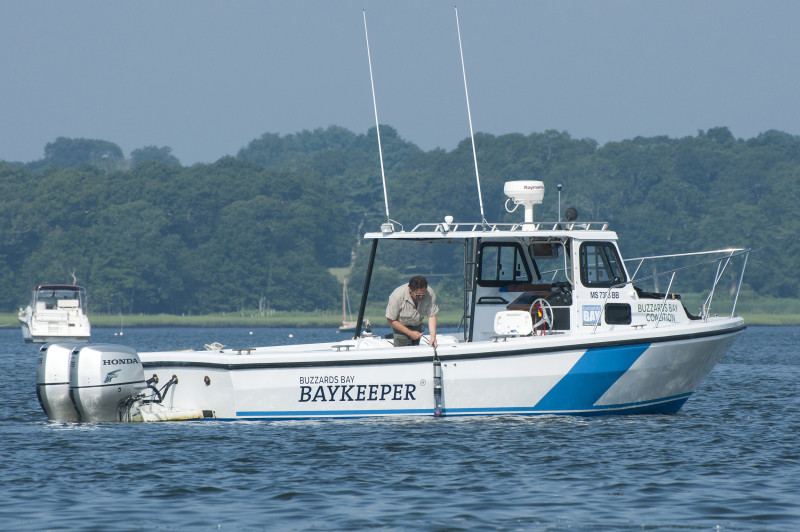Third summer of water monitoring kicks off on Martha’s Vineyard
Building on over 25 years of tracking the health of local waters through the award-winning Baywatchers program, the Buzzards Bay Coalition continues to expand its monitoring to new waters whose ecological fates are linked to Buzzards Bay. This summer, the Coalition and partners at the Martha’s Vineyard Commission (MVC) and the Aquinnah Wampanoag Tribe are undertaking a third year of studying the health of Vineyard Sound and four coastal ponds on the island’s north shore.
On every tide, water exchanges between Buzzards Bay and Vineyard Sound, flowing through passages in the Elizabeth Islands and Woods Hole. The physical connections between Buzzards Bay and Vineyard Sound link the health – and futures – of Vineyard Sound and the Bay.

The R/V Buzzards Baykeeper® monitors the health of waterways connected to Buzzards Bay throughout the summer.
The Coalition began monitoring Vineyard Sound in 2012, as a benchmark for comparison with central Buzzards Bay waters. Vineyard Sound faces the same pressures as Buzzards Bay, including nitrogen pollution from Cape Cod and Martha’s Vineyard and warming waters from climate change.
What Baywatchers research has so far found is encouraging: Vineyard Sound has among the healthiest waters of all of the places that the Coalition studies, with clear waters and very little nitrogen pollution.
In 2017, the Coalition began collaborating with the MVC and the Wampanoag Tribe to expand monitoring to four salt ponds on the north shore of the Vineyard: Menemsha Pond, Squibnocket Pond, James Pond, and Lake Tashmoo. These four ponds connect to Vineyard Sound, and empty some of their waters out into the Sound with every tide.

Menemsha and Squibnocket Ponds are connected by a herring run on the Wampanoag Tribe lands.
Each of these ponds has its own character. James Pond is relatively small and shallow, with only a limited connection to Vineyard Sound and few houses around it. Lake Tashmoo is larger, with a wider opening to Vineyard Sound, and is deep enough for a large number of boat moorings. Menemsha Pond is the largest of the four ponds, with the biggest opening to and connection with Vineyard Sound. Squibnocket Pond is connected to Vineyard Sound through Menemsha Pond by a stream. Each spring, river herring swim up this stream to spawn in Squibnocket Pond.
Despite their differences, all of these ponds are more impacted by the effects of nitrogen pollution than the Sound, especially as development continues on Martha’s Vineyard. The threat to these ponds is the same as all around Buzzards Bay: residential septic systems. Only by consistently monitoring pond health can local officials begin to tackle cleanup options.
This monitoring has also provided useful comparisons for ongoing monitoring work on the Vineyard by the Aquinnah Wampanoag Tribe. The Tribe has been monitoring the health of Menemsha Pond, a source of sustenance foods and an important piece of the culture and livelihoods of Tribe members, since 1996. The Coalition’s monitoring in Menemsha and the north shore’s other salt ponds allows the Tribe to evaluate how Menemsha Pond’s conditions compare to other places on the Vineyard and around Buzzards Bay.
Every week during the summer, the Coalition and our Vineyard partners will monitor oxygen, temperature, salinity, and water clarity in Vineyard Sound and the island’s four coastal ponds. On four days in July and August, they will also collect samples for detailed analysis of nitrogen and algae concentrations.
This monitoring gives us direct evidence about how nitrogen pollution affects the health of your waters. Like all of the Coalition’s Bay Health data, this information will be freely available for local organizations to use in their own work, providing a resource for communities to protect these interconnected places and the health of their waters.